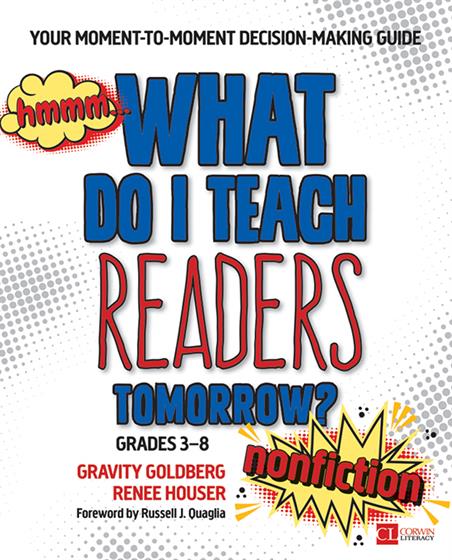
Hands-on, Practical Guidance for Educators
From math,
literacy, equity, multilingual learners, and SEL, to assessment, school counseling,
and education leadership, our books are research-based and authored by experts
on topics most relevant to what educators are facing today.
What Do I Teach Readers Tomorrow? Nonfiction, Grades 3-8
Foreword by Russell J. Quaglia
- Grade Level: 3-8
- ISBN: 9781506351216
- Published By: Corwin
- Series: Corwin Literacy
- Year: 2017
- Page Count: 296
- Publication date: January 31, 2017
Review Copies
Review copies may be requested by individuals planning to purchase 10 or more copies for a team or considering a book for adoption in a higher ed course. To request a review copy, contact sales@corwin.com.
Description
“Well, that was a great minilesson—now what?”
For every teacher who has uttered those words, this book is for you. In What Do I Teach Readers Tomorrow? Nonfiction, educators Gravity Goldberg and Renee Houser take the guesswork out of determining students’ needs with a moment-to-moment guide focused on the decisions that make the biggest impact on readers’ skill development. With the authors’ guidance, you put their next-step resources into action, including:
- Tips for what to look for and listen for in reading notebook entries and conversations about books
- Reproducible Clipboard Notes pages that help you decide whether to reinforce a current type of thinking, teach a new type of thinking, or apply a current type of thinking to a new text
- More than 30 lessons on synthesizing information and understanding perspectives, writing about reading, organizing thinking, and more
- Reading notebook entries and sample classroom conversations to use as benchmarks
- Strategies for deepening the three most prevalent types of thinking students do when synthesizing: Right-Now Thinking (on the page), Over-Time Thinking (across a picture book, a chapter, or longer text), or Refining Thinking (nuanced connections across text and life concepts)
- Strategies for deepening the three most useful types of thinking—feelings, frames, and opinions—when considering perspectives
- Online video clips of Renee and Gravity teaching, conferring, and “thin slicing” what nonfiction readers need next
With What Do I Teach Readers Tomorrow? Nonfiction, you learn to trust your instincts and trust your students to provide you with information about the next steps that make the most sense for them. Teaching students to engage with and understand nonfiction becomes personal, purposeful, and a homegrown process that you can replicate from year to year and student to student.
“Goldberg and Houser – both former staff developers at the Teachers College Reading and Writing Project – have perfectly combined theory and practice to help teachers put students first in their decision-making process. Best of all, they’ve provided the tools necessary to assist teachers in making those decisions become a reality right away.”— Reviewed by Pam Hamilton for MiddleWeb
Key features
Author(s)

Gravity Goldberg

Renee W. Houser
Renée Houser is a lifelong educator, literacy consultant, and co-author of the series What Do I Teach Readers Tomorrow? Her entire career has been dedicated to supporting students and teachers. She taught in New York City public schools, worked as a staff member at the Reading and Writing Project at Teachers College, and holds graduate degrees from Old Dominion University and Fordham University. In 2019, she founded Read. Write. Think. with Renee where she serves as an educational thinking partner for schools around the country. In this role, she is able to facilitate collaborative professional learning opportunities, create relevant resources for educators, and be a champion for student success.
Table of Contents
Foreword
Acknowledgments
A Quick-Start Guide for Easy Access
Chapter 1: Each Classroom Moment Is an Instructional Decision
Acting Without a Script: Embracing Our Role as Improvisers
Answering the “What Next?” Question
Intentional Teaching: Decision Making With Students at the Center
Self-Reflection Questionnaire: What Type of Decision Maker Are You?
Decision-Making Styles
Three Common Teaching Habits
Let Students Be Your Guide
Getting Started: An Action Plan
Chapter 2: Decisions About Book Selection
Making a Choice to Read Aloud a Nonfiction Text
Narrative Nonfiction
Persuasive Nonfiction
Expository Nonfiction
Mash-Ups
5 Ways to Engage Students in Nonfiction Read Alouds
Chapter 3: Decisions About Reading Notebooks
Why We Really Use Writing as a Tool for Understanding
Current Reality: Why Students Write About Reading in School
Writing About Reading: An Important Tool for Readers and Their Teachers
How to Collect Thinking in Notebook Entries
Self-Reflection Questionnaire: Reading Notebooks
What We Might Let Go of When Asking Students to Write About Reading
Reading Notebooks: An Action Plan
Chapter 4: Decisions About Discussion
The Benefits: Making Meaning in Texts and Our Lives
Teach Students to Have Meaningful Conversations
Making Decisions Based on Student Conversations
Effective Nonfiction Conversation Characteristics
What We Might Let Go of When Asking Students to Talk About Their Reading
Self-Reflection Questionnaire: Student Conversations
Authentic Conversations: An Action Plan
Chapter 5: Decisions About Synthesizing Information
What Is Synthesis?
Why Is Synthesis So Important?
What Other Reading Skills Fit With Synthesis?
What to Look for When Students Synthesize Information
Thin-Slicing Students’ Synthesis Thinking
Decide What to Teach Next: Focus on Three Main Choices
Synthesis Across Texts
Synthesizing Information: An Action Plan
Chapter 6: Decisions About Understanding Perspectives
What Is Perspective?
Why Is Understanding Perspectives Important?
What Other Reading Skills Fit With Understanding Perspectives?
What to Look for When Understanding Perspective
Decide What to Teach Next
Reflecting With Students: How Understanding Perspectives Helps Us
Understanding Perspectives: An Action Plan
Chapter 7: Becoming Confident and Intentional Decision Makers
Appendices
Appendix A. Nonfiction Book Rating System
Appendix B. Some Favorite Nonfiction Texts
Appendix C. Clipboard Notes: Reading Notebook Entries
Appendix D. Clipboard Notes: Student Conversations
Appendix E. Synthesizing Nonfiction Texts
Appendix F. Clipboard Notes: Types of Thinking About Synthesizing Information
Appendix G. Understanding Perspectives in Nonfiction
Appendix H. Clipboard Notes: Types of Thinking About Understanding Perspectives
References
Index
Reviews
"We know of no resource that promotes responsive teaching as well as these books do. Goldberg and Houser like teaching to improve, and then describe how teachers can learn to be fully in the moment of instructional decision making by focusing on a handful of things. From the detailed lessons to boxes titled, 'Decide to teach this tomorrow if your students . . .' these authors anticipate the content teachers want and the questions they raise. These thoughtful books show teachers how to make children’s reading needs central to instructional planning."Kim Yaris and Jan Burkins
Authors of Who’s Doing the Work?
"I love this series! Goldberg and Houser succeed at something difficult: freeze-framing their intentional decisions about teaching readers in a way that we can all “see”—and then do in our own classrooms. They provide a decision-making model that helps teachers feel confident in letting their own observations of students’ written and spoken responses to text guide them. They distill the ever-present what-do-I-teach-next question into three choices, and these choices all center on furthering students’ ways of thinking as they read fiction and nonfiction. Through classroom videos and notebook entries, we learn the authors’ intuitive process. They don’t just leave us pondering, but scaffold our ability to be responsive teachers by providing lesson ideas that work for every kind of tomorrow—every reading next step. For fiction, they share lessons on character and theme; for nonfiction, on synthesizing information and understanding perspectives. The bonus is this: when we study and reflect on the authors’ decision-making process, we enhance and improve our own. These books should become seminal works."Laura Robb
Author of Read, Talk, Write
"Making decisions about reading in our classroom is not easy, even though we make hundreds every day. Often, we don’t give much thought to how we decide what we do, but with this book, we are taken on a guided tour of what it means to make super-intuitive decisions about what our readers need next. Each chapter addresses decisions about key aspects of building a literature-rich environment and a community of readers, including reading notebooks, teaching students how to synthesize ideas, and understanding perspective. The chapters on great nonfiction and fiction texts and on helping readers learn how to select involving books are favorites, as they give me a more focused method to rely on. The books are practical, friendly, and chockfull of ideas and lessons that can be readily implemented."Grace White, Supervisor of Curriculum
Wykoff School District, NJ
"These books exemplify the intersection of excellent scholarship and practical application for teachers in the field. They beautifully illustrate those essential metacognitive processes in a progression, and this helps teachers see how instructional decisions become instructional moves that translate into high cognitive demand learning experiences for students. This series an invaluable teaching tool for those who want to implement authentic Balanced Literacy experiences for their students."Dr. Akida Kissane Long, Principal
Florence Griffith Joyner Elementary, Los Angeles Unified School District, CA
"Goldberg and Houser offer an insider’s view of intentional decision making in action by making us front-row observers of their thinking process. We stand beside them as they show us student-centered reading instruction at its best, listening in on book conversations, gazing over their shoulders to analyze writing in reading notebooks. This step-by-step journey yields explanations of why, what, and how that we can use to plan next lessons for our readers. The What Do I Teach Readers Tomorrow? series is a testament to our professional responsibility to keep students as our compass, their 'right now' needs and wishes as readers as the destination, and engaging books as the vehicle that takes us there."Dr. Mary Howard
Author of RTI From All Sides: What Every Teacher Needs to Know
"This series is a must-have for every elementary language arts teacher! Goldberg and Houser have created a comprehensive support for teachers who want to provide their students with rigorous, thinking-centered experiences in reading and writing. Having these books is like having ongoing coaching and guidance from these two outstanding literacy experts at your fingertips."Jerry Harris, Director
The Cotsen Foundation, The Art of Teaching
"I love the we-are-right-there-with-you tone. It’s so clear these authors have been there, and remain right in the trenches. And I love the teacher checklists and quizzes—just the right light touch to use in professional development time. But perhaps most of all, I admire that Houser and Goldberg have taken a complex process—daily instructional decision making— and broken it into doable steps for teachers to try. Deciding what each reader in your room is ready for next will never be something a teacher gets good at overnight, but with these outstanding resources, educators are armed with the right questions to ask themselves, a progression of strategies that enhance the readers relationship with the text, and the theory and research from in and out of the literacy field that will help them build a community of readers."Joyce Friedman
“Goldberg and Houser—both former staff developers at the Teachers College Reading and Writing Project—have perfectly combined theory and practice to help teachers put students first in their decision-making process. Best of all, they’ve provided the tools necessary to assist teachers in making those decisions become a reality right away.”Pam Hamilton
MiddleWeb
Review Copies
Review copies may be requested by individuals planning to purchase 10 or more copies for a team or considering a book for adoption in a higher ed course. To request a review copy, contact sales@corwin.com.
Related Resources
- Access to companion resources is available with the purchase of this book.

